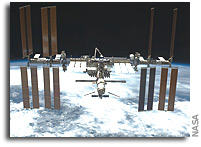NASA Space Station Lead Increment Scientist’s Highlights for the week of Jan. 23, 2012

(Highlights: Week of January 23, 2012) — Don Pettit and Andre Kuipers completed the SPHERES-Zero-Robotics Challenge 2011 activity. The competition was executed live aboard the station with the student teams participating in this challenge using robotic, bowling-ball-sized satellites called SPHERES, or Synchronized Position Hold, Engage, Reorient, Experimental Satellites. SPHERES are used inside the space station to test autonomous rendezvous and docking maneuvers. The free-flying satellites are self-contained with power, propulsion, computers and navigation equipment. For the Zero Robotics competition, the students developed and wrote software code for the SPHERES and space station astronauts conducted 16 runs as the students watched live on NASA-TV. Alliance Rocket students from the United States and virtual participants Alliance CyberAvo, representing schools in Germany and Italy, were named the winners.
Don Pettit built a Solar Dynamics Observatory and Radar Satellite for the LEGO(R) Bricks investigation. This educational investigation includes a series of toy LEGO(R) kits that are assembled on orbit and used to demonstrate scientific concepts. He recorded the construction for an educational video.
Capillary Flow Experiments – 2 (CFE-2) is a suite of fluid physics investigations that study how fluids move up surfaces in microgravity. During a session on Jan. 27, Dan Burbank and the ground team observed fluid interface and critical wetting behavior in a cylindrical chamber, with elliptic cross-section and an adjustable central perforated vane. The critical vane-gap wetting phenomenon occurs at a critical vane angle where the fluid rises all the way up the gap between the vane and chamber wall. Results of this investigation aim to improve current computer models that are used by designers of low gravity fluid systems and may improve fluid transfer systems for water on future spacecraft. On Earth, CFE-2 results are also being considered for improving fluid flow in miniaturized biological devices used for health screening and analysis.
Burbank and Pettit completed more sessions of the Cardiac Atrophy and Diastolic Dysfunction During and After Long Duration Spaceflight: Functional Consequences for Orthostatic Intolerance, Exercise Capability and Risk for Cardiac Arrhythmias (Integrated Cardiovascular). This investigation determines how much cardiac atrophy, or decrease in heart muscle, occurs during spaceflight and how fast it develops, whether this atrophy causes problems with the heart’s pumping or electrical function, and how both the atrophy and any associated changes develop. On Earth, the information obtained in this investigation has relevance for patients after prolonged confinement to bedrest, or chronic reduction in physical activity, as well as for patients with disease processes that alter cardiac stiffness such as congestive heart failure.
Burbank and Kuipers began sessions for the European Space Agency’s Sodium Loading in Microgravity (SOLO) experiment. Microgravity leads to an activation of sodium retaining hormones, which in turn worsens the breakdown of bone. SOLO studies the mechanisms of fluid and salt retention in the body during spaceflight by monitoring nutrient intake, collecting urine, measuring body mass and collecting blood.
Jorge Sotomayor, Lead Increment Scientist
Expedition 29/30








